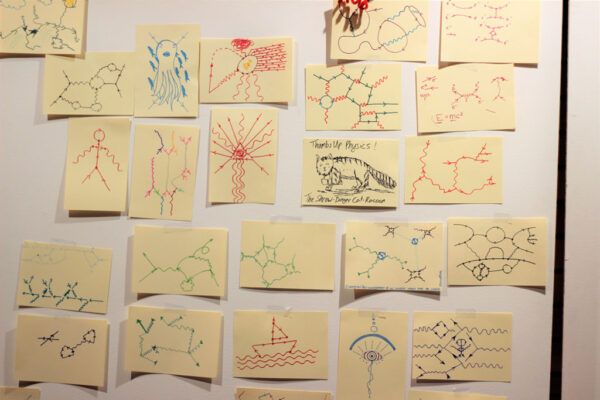Sometimes the shortest distance between a concept and understanding is a squiggly line. It was Richard Feynman, the Nobel prize-winning American theoretical physicist, who famously proposed cartoon models as a way to communicate complex physical equations more simply; in doing so, he fundamentally altered how physicists think and show their work. In a new paper in the journal The Physics Teacher, James Day and colleagues detail their approach to learning to think like a physicist, offering exercises for how to teach complex math problems using cartoons, or “toy models.”
A toy model is a purposely simple image used to convey complex information efficiently. Theoretical physicists often use Feynman diagrams, a variation on toy models, to explain complex mathematical expressions to describe the behaviour of quantum particles.
“Before Feynman, theoretical physicists used these very complex mathematical equations to describe quantum electrodynamics,” said Day. “Feynman realized that drawings could simplify things, getting us to the same place with the same integrity, but much faster.”

Pictured: an example of a Feynman diagram.
“Feynman tell us that if you take the right lateral step, you can make a major breakthrough,” said Day. “Quantum mechanics, or theoretical physics in general, are topics that anyone can understand; it might not seem that way if you don’t know the language, but you can learn.”
By creating a visual language for complex ideas, these ideas become more accessible to those who do not speak the language of quantum mechanics. Even when they seem simple, Feynman diagrams are useful across a range of experiences.
“The experts are drawing these squiggles and discovering new things about the universe,” said Day.
Learning the language and creating a framework
Day is an experienced science communicator, often relying on analogies and images to get his point across. In 2018, Day partnered with colleagues including Oguzhan Can, Theresa Liao (UBC Physics) and Char Hoyt (Curiosity Collider) to deliver physics demonstrations at Night Shift: Quantum Futures, a public event and performance at the Museum of Anthropology.
The team developed a series of activities to enable them to teach some basic concepts in quantum physics to general audiences who may not have experience in the field. For Day, who frequently communicates in analogies to audiences who are less familiar with quantum mechanics, this was an opportunity to test analogies with artists to find out where they might fall apart for lay audiences.
“Mapping our learning objectives gave us a jumping-off point for ideas we could use, and working with artists enabled us to make these accessible and engaging,” said Day.
The team wanted to keep things simple.
“Feynman diagrams have rules, and so we picked a few straightforward guidelines,” said Day. One of the goals was to have participants create a particle interaction; testing these with the artists, the team began to see where rules were broken, so they could figure out how to clarify their messaging and better design the exercise and improve the steps. The team found that when the rules were broken, it was almost always intentional—participants were experimenting, or trying to influence the shape of the diagrams in creative ways.

An example of a Feynman-style drawing created by Quantum Futures participants. Image source: James Day.
“Think about kids playing soccer. The most important thing is to get them on the field with the ball. As they play, you can clarify the rules as the important ones get broken, and refine the process until they can play without breaking the rules,” said Day.
By the time the event took place, the team had engineered an exercise that made the quantum scattering of fundamental particles accessible to lay audiences in an informal setting. While the Quantum Futures event was supported by graduate students in physics who able to decipher the participants’ work, the paper offers clear instructions for building a similar activity into a physics lesson in a school environment.

A close-up of several of the figures created by the participants. Image source: James Day.
“We saw that very few of the rules were actually broken,” said Day. “It’s important to establish specific learning goals in advance; we’re really putting the outcome first, and working our way back to it.”
Lateral thinking drives learning
The team emphasized lateral thinking in this exercise, an important skill for anyone—expert physicist or not—to have.
Lateral thinking is less about thinking a problem through to its logical conclusion than it is about approaching it from a completely different angle. It requires creativity, and the ability to see solutions outside of logical steps: it is thinking outside the box, or, more accurately, not paying much attention to the box in the first place.
“Lateral thinking is about looking at a concept in a new way, or finding a connection that had been there all along, but that no one has noticed yet,” said Day. “Sometimes it’s about putting the solution first, and finding a way there.”
At the Stewart Blusson Quantum Matter Institute (Blusson QMI), lateral thinking and creative problem solving underpin much of the work that takes place.
“None of these big, complex ideas are truly inaccessible,” said Day. “And anyone can learn to think like a physicist.”
“One great thing about Blusson QMI is that we’re all colleagues, but we’re not doing the same thing,” said Day. “We’re able to dig deeply, but we’re not all digging in the same spot. Some of the biggest breakthroughs have come not from digging the deepest holes, but from those who combined their efforts and determined the best spot to dig holes together.”


